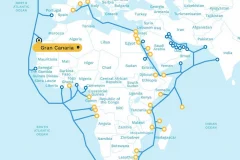In the Polo shopping mall in Enugu, there are two competing grocery retailers on either sides of the mall – about 150 meters apart – Game and Shoprite. Both have similar inventories and pricing. For some items, however, the disparity between Shoprite prices and Game prices is up to 20%. So when my friends go to shop for the month, they split up; one goes into Game, the other into Shoprite.
While there, they share pictures and compare prices from both stores via Whatsapp. “We buy from the one with the best price and meet up later. It’s the best way to get a good bargain,” one of them said, smiling at their scheme.
I had to give it to them. It was pretty genius. They save close to N5,000 on groceries just by doing this.
This was in Enugu, in 2013. So, you’ll excuse them if they didn’t think to use a price comparison website. Moreover, even now, there still aren’t price comparison websites for brick and mortar stores like Shoprite, so I imagine my friends were not alone in this (and still aren’t).
This is just one of the ways mobile is augmenting the physical shopping experience.
Other people do this in different ways. According to a GFK study in June 2015, one of out every two shoppers, usually between ages 20 and 29, compare prices online while inside a store. Some also call family and friends to make sure no corporate setup if ripping them off.
“Men and women are almost equally likely to use their mobile phones inside a store to contact a friend or family member for advice (40% of women and 39% of men say they regularly do this),” a part of the report says.
One of the concerns, as smartphones and mobile data become increasingly accessible in Africa, is that e-commerce will eclipse sales from brick mortar stores, just as it has done in the US and Europe. However, in Africa, this pattern seems to be going in the other direction.
In South Africa, according to PwC’s Total Retail 2015 report[PDF], 81% of online shoppers still prefer to do their regular shopping in-store.
For the Mr. Price Group in South Africa, their website which opened in 2012 is mostly driving offline sales. Instead of creating buyers who buy exclusively online, the emergent behavior is that buyers browse online, and go in-store to make purchases.
I have done this multiple times as well. I window shop online and then walk in to the physical store to make the purchase. My excuse is that this cuts down on the amount of time I spend at the store and insulates me from impulse purchases I will sulk over for the rest of the month.
Of course, I am only one in a multitude of buyers and there is no data to support this in Nigeria but from observation, the patterns are similar.
Mobile ecommerce apps and websites are becoming more popular. In Nigeria, Jumia, DealDey and Konga have consistently remained one of the most-trafficked websites and their mobile apps boast of decent download figures. But footfalls at brick at mortar stores haven’t reduced noticeably.
One of the reasons I have heard people give for this behaviour in Nigeria is the dearth of trust for the quality of the inventory of online shopping outposts. The same fear is behind most buyers’ refusal to pay before service on the ecommerce website. Another fear is the security of online payment switching companies, holding back buyers from using their cards online.
It’s possible this growth won’t continue for a long time, though a few outfits are already responding to this continued growth in mobile enhanced offline shopping. Kaymu recently opened its Kaymu Village and Yudala is launching both offline and online stores. It’ll be interesting to see how online orders compare to offline purchases in these stores. However, offline shopping is safe for now.
Photo Credit: Martino’s doodles via Compfight cc





















